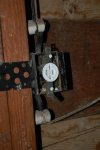brycenesbitt
Senior Member
- Location
- United States
I've got a wall to insulate, but the inspector is asking for 6' of clearance to the knob and tube wiring. The K&T is in good shape and terminates in a single outlet.The general on the job suggest cutting the K&T back to a junction box, then running romex down the wall. Is this a reasonable approach? And if so, it is reasonable to then find a true earth ground and hook up the equipment ground?----------Note: this is California so Article 394 could apply: California permits insulation over K&T with an inspection certificate. This particular house has 12 gauge K&T. The main house feed is three wires with a shared neutral, protected by a 15 amp double pole AFCI breaker. Kitchen & Laundry are on new circuits.Here's a photo of the current outlet (construction date 1938):






